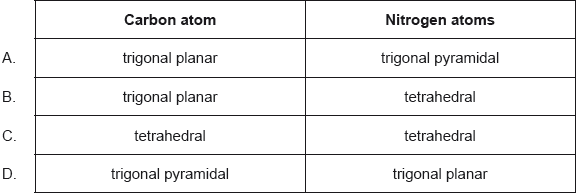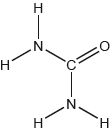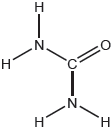| Date | May 2019 | Marks available | 1 | Reference code | 19M.2.hl.TZ1.5 |
| Level | HL | Paper | 2 | Time zone | TZ1 |
| Command term | Draw | Question number | 5 | Adapted from | N/A |
Question
Both vinegar (a dilute aqueous solution of ethanoic acid) and bleach are used as cleaning agents.
Bleach reacts with ammonia, also used as a cleaning agent, to produce the poisonous compound chloramine, NH2Cl.
Outline why ethanoic acid is classified as a weak acid.
A solution of bleach can be made by reacting chlorine gas with a sodium hydroxide solution.
Cl2 (g) + 2NaOH (aq) ⇌ NaOCl (aq) + NaCl (aq) + H2O (l)
Suggest, with reference to Le Châtelier’s principle, why it is dangerous to mix vinegar and bleach together as cleaners.
Draw a Lewis (electron dot) structure of chloramine.
State the hybridization of the nitrogen atom in chloramine.
Deduce the molecular geometry of chloramine and estimate its H–N–H bond angle.
Molecular geometry:
H–N–H bond angle:
State the type of bond formed when chloramine is protonated.
Sketch a graph of pH against volume of hydrochloric acid added to ammonia solution, showing how you would determine the pKa of the ammonium ion.
Suggest a suitable indicator for the titration, using section 22 of the data booklet.
Explain, using two equations, how an equimolar solution of ammonia and ammonium ions acts as a buffer solution when small amounts of acid or base are added.
Markscheme
partial dissociation «in aqueous solution» [✔]
ethanoic acid/vinegar reacts with NaOH [✔]
moves equilibrium to left/reactant side [✔]
releases Cl2 (g)/chlorine gas
OR
Cl2 (g)/chlorine gas is toxic [✔]
Note: Accept “ethanoic acid produces H+ ions”
Accept “ethanoic acid/vinegar reacts with NaOCl”.
Do not accept “2CH3COOH + NaOCl + NaCl → 2CH3COONa + Cl2 + H2O” as it does not refer to equilibrium.
Accept suitable molecular or ionic equations for M1 and M3.
[✔]
Note: Accept any combination of dots/crosses or lines to represent electron pairs.
sp3 [✔]
Molecular geometry:
«trigonal» pyramidal [✔]
H–N–H bond angle:
107° [✔]
Note: Accept angles in the range of 100–109.
covalent/dative/coordinate [✔]
correct shape of graph AND vertical drop at Vn [✔]
pKa = pH at /half neutralization/half equivalence [✔]
Note: M1: must show buffer region at pH > 7 and equivalence point at pH < 7. Graph must start below pH = 14.
methyl orange
OR
bromophenol blue
OR
bromocresol green
OR
methyl red [✔]
NH3 (aq) + H+ (aq) → NH4 + (aq) [✔]
NH4 + (aq) + OH− (aq) → NH3 (aq) + H2O(l) [✔]
Note: Accept reaction arrows or equilibrium signs in both equations.
Award [1 max], based on two correct reverse equations but not clearly showing reacting with acid or base but rather dissociation.
Examiners report
Majority of candidates understood weak acids do not fully dissociate.
The average score was 1 out 3. Many could not suggest why it is dangerous to mix chlorine with vinegar. Most students gained at least one mark for stating that “chlorine gas will be produced” but couldn’t link it to equilibrium ideas.
Most candidates correctly drew the Lewis structure of chloramine. Some left off lone pair electrons.
Mostly correct with a surprising number stating sp or sp2 hybridization.
Generally well done with some candidates misinterpreting the bond angle from the stated geometry.
“Ionic bond”, “hydrogen bond” and “intermolecular forces” were some common answers.
Quite poorly done with many candidates not indicating a vertical drop but rather a weak acid/weak base curve. Some did not have the correct location for the equivalence point.
Generally well done although a number of candidates chose bromothymol blue as a suitable indicator for weak base with a strong acid.
Nearly 30 % of candidates did not attempt to answer this question about buffer equations. It was also poorly answered because equations were not used to explain buffer action or the dissociation equations for the base and acid were given rather than their reactions with H+ or OH- .








